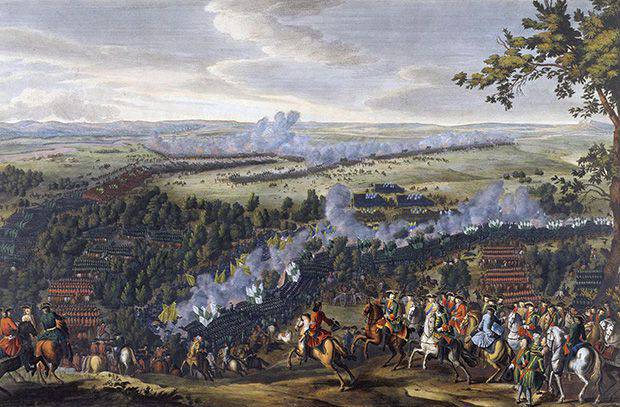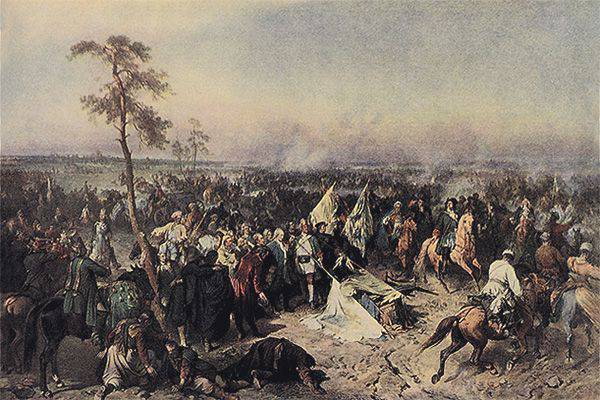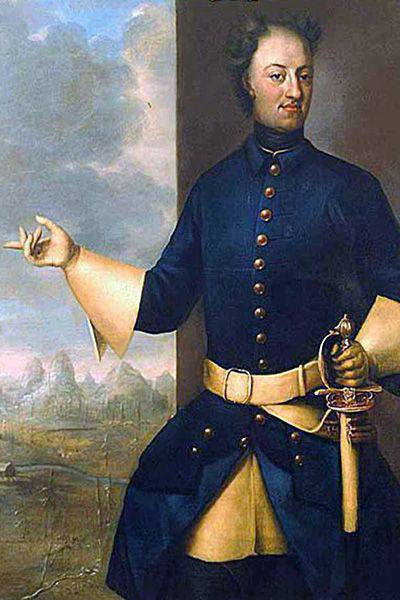Battle of Forest: Mother of Poltava victory

How Peter I managed to deprive the Swedish army going to Moscow for the main convoy and dispel the myth of its invincibility
The Northern War, which was transformed from a kingdom into an empire, led Russia to gain access to the Baltic and Western Europe, is best known for the Battle of Poltava. But Peter I himself until the end of his life believed that the success of the Poltava battle was unthinkable without another, much less well-known today won battle.
This is a battle at Lesnaya, which unfolded 28 September (9 October in a new style) 1708 of the year on the shores of Lesnianki, southeast of Mogilev. In the battle, the flying corps, the corolant, under the command and with the personal participation of Peter, succeeded in crushing the Swedish corps of General Adam Ludwig Levengaupt. At the same time, the initial balance of forces was not in favor of the Russians: the corolant numbered only 11 600 people and 30 guns, while the enemy had 16 000 soldiers and officers with 17 guns.
Peter rightly described the victory at Lesnoy as “the first soldiers' test” and “the mother of the Poltava victory”. Despite the fact that several years earlier, Russian troops took control of the entire Neva, laid siege and captured the fortresses Noteburg, Dorpat and Narva, the failure of the Polish campaign and the attack on Russia by the Swedish king Charles XII demanded new victories. They were needed, like air ...
“As soon as a new sovereign is established ...”
The Russian campaign of Charles XII, which contemporaries and later researchers unanimously call an excellent tactician, but a poor politician, was launched with the sole purpose of completely destroying the nascent Russian Empire. The king did not hide his intentions: to overthrow Peter and dismember the country into specific princedoms. He wanted to take away from the Russians all the conquests of the first stage of the Northern War — Ingermanland and the former Swedish fortresses, to push them away from the Neva and not allow St. Petersburg to be built. At the same time, Karl believed that it was necessary to sign a peace treaty in Moscow, "dictating its conditions with the point of his sword."
Karl fully trusted his new advisers from among foreigners who had previously served the Moscow throne, but had fled to Sweden. They guaranteed the inevitability of mass riots in Russia, tormented by Peter's reforms. The riot was seen as an additional guarantee of the success of the campaign, and in order to excite the population, in Amsterdam even printed leaflets in Russian. They frankly said that the Swedish army would free the people from the yoke of the Moscow government, from foreign oppression and torment for the free choice of the legitimate and righteous sovereign instead of Peter. "As soon as a new sovereign is established, the Swedish king will lay down weapon, but will help everyone who is on his side, ”the Swedes admonished potential, as it seemed to them, allies.
However, even without them, the Swedes had good reason not to doubt the success. The Russian army was lucky in the first half of 1700, and in the second half Stockholm managed to turn the situation in its favor. Miraculously avoiding the defeat at Grodno in 1706, Russia was forced to curtail most military operations and start rebuilding and rearming the army literally on the move. And if it were not for the king’s confidence that the Russians would not be able to cope with this task in such a short time, Moscow wouldn’t get her needed respite from 1707 – 1708, when the Swedes slowly crossed Eastern Poland and Western Belarus, getting closer and closer to our borders.
Scorched Land Tactics
But there was a respite, and Peter took advantage of it. It was impossible not to notice the advance of the Swedish army to the east, and it remained to decide where to fight: on Polish soil or within its borders. Peter and his advisers made the decision to move east and fight on their land. And by the decree of the king managed to prepare. Along the Russian border, there appeared a “line of Peter I,” which was a strip of intersections that blocked almost all the main and secondary roads leading to the east, and the shafts that crossed the fields.
To make it impossible for the enemy to supply the army at the expense of requisition, the peasants were ordered to prepare shelters for forage, livestock, and people in advance. The Swedish army that fought in the Baltic could only operate successfully in an uninterrupted supply from the sea, but in Poland, the Swedes, not having a well-established supply, were forced to stay long in place in order to withdraw supplies from the population.
It was to the war with the enemy, deprived of normal supply, that Peter I staked. It was for this purpose that the "Peter Line" was built. That is why the peasants were ordered to shelter supplies and livestock. Precisely in order to force the Swedes to stretch their rear communications and act in conditions of shortage, the Russian army retreated inland. And the most severe blow, from which the army of Charles could not recover even to Poltava, was still ahead ...

Carriage for Charles XII
Back in February, 1709, General Lewenhaupt began to carry out the order received from Karl to take up procurement of provisions, fodder, stocks of gunpowder and ammunition and to be ready to launch a campaign to join the main forces. The fact that Levengaupt took up the execution of the royal will, in Moscow, learned almost immediately. There was no way to hide large-scale confiscations of stocks and carts from the infants of the Russian General Rodion Bour, the commander of the cavalry corps standing near Riga. But to establish the exact route by which all this good will go, Russian intelligence failed. It was assumed that the corps of Levengaupta will speak to Narva or to Poland. It became clear that he would go to Belarus to join up with Karl only in early June.
By this time, Karl once again managed to convince himself of the weakness of the Russian army, having won an easy victory over the division of General Anikita Repnin near Golovchin. Forcing the Russians to retreat, Karl decided to wait for the Levengaupt corps: there was not enough food and forage on the ravaged land.
Ironically, both sides — Levengaupt and Peter I — were deluded as to the strength of the enemy. The Swede, having learned about the persecution of the Russians, decided that it was not the corolant who marched against him, but the vanguard of the whole army. That is why Levengaupt and decided to give battle, hoping to win an easy victory and at the same time reduce the number of Russians opposing the main forces of the Swedes. The Russian side was deceived about the size of the enemy in the other direction. As follows from the documents relating to Peter’s personal archive, 7 July 1708, a deserter appeared in the Russian army’s location in Dorpat — an Estonian dragoon mobilized into the cavalry regiment of Major-General Volmar Anton Schlippenbach, who was part of Levengaupt’s corps. He said that at the end of June the entire corps was to move to join up with Karl, adding that Levengaupt had six regiments of infantry and as many cavalry. This made the evaluation of the enemy forces in incomplete 8000 people.
"The importance of the goal did not allow the refusal of the fight"
In fact, Levengaupt’s corps numbered slightly more than 16 000 people. All this mass, forced to equalize the speed of movement with the speed of a cart of 7000 carts, moved slowly. Only 19 September reached the Dnieper and only two days later was able to cross. However, the Russian army was not in a hurry either, having no idea where and how the enemy was heading. In addition, when the corolant was ready to speak, the scout who had been sent by Lewenhaupt managed to confuse his commanders, stating that he knows for sure: the Swedes are planning to cross the Dnieper in Orsha.
That this was misinformation, it became clear only the next day, when the Swedes were already ahead of the Russians on the way to the main forces of their army. Now the Russians were not to prepare for the oncoming battle, but with a quick march to go after the enemy. “This circumstance, however, did not embarrass Peter; - he continues to move closer to the enemy, while remaining firmly intent on attacking the Swedes, - Pavel Andrianov, lieutenant colonel of the General Staff, wrote in 1911 in his work in The Epoch of Peter the Great. - Sending Bour, who was at Cherikov's order to rush to join the light corps, Peter, having occupied the village of Dolgiy Mokh, decided only to wait for Bour for two days, and if he did not arrive during this period, then he would attack the Swedes, despite the inequality of forces. Calculation Peter was completely consistent with the situation. The importance of the goal did not allow refusal from the fight. With the successful outcome of the attack, results of tremendous importance were achieved; in the case of failure, Peter risked little, since Levengaupt, having repelled the Russian attack, but being connected by a huge transport, could not harm the light detachment. ”

Andrianov continues: “Upon learning of the proximity of the Russians, Levengaupt, first of all, takes measures to rescue ... the vital transport to Karl XII. Under the cover of the 3-thousandth avant-garde, the transport goes to Propoisk in order to quickly cross the Sozh river along the existing ... bridge and quickly put a barrier between the transport and the Russian squad pursuing it. With other forces, wanting to win as much time as possible, Levengaupt stops at a position near the village of Dolgiy Mokh, trying to detain the Russians on the crossing over the marshy river Restu. Peter advanced five guns to the crossing point, and under the cover of artillery fire our troops crossed the stream. Then the Swedes moved several miles and began to prepare for battle near the village of Lesnaya. ”
“This victory may be the first to be called”
Russian troops, marching in two columns, one of which was commanded by Prince Alexander Menshikov, and the other by Peter himself, were forced to enter the battle directly from the march. The vanguard of the Menshikovsky column collided with the Swedes on their way to the battle site on the morning of September 28. Six Swedish battalions were eventually forced to retreat, but allowed the main forces to prepare for repelling the first Russian attack, one of a dozen.
In total, the battle lasted half a day. It was not until seven in the evening, “when the soldiers on both sides were so tired that it was no longer possible to fight, and then the enemy was at his own convoy, while our soldiers sat down at a fighting place and rested with pleasure”.
Only gunners continued their military business: an artillery duel between Russians standing in the field and retreating to Wagengen (a fortified camp, which was based on the Swedes assembled in a circle and covered with board shields), went until ten in the evening. And under the cover of night, having set fire to part of the wagons and leaving all the sick and wounded in the wagenburg, Levengaupt most secretly brought out the main body of the hull and quickly retreated. In the Russian camp it was discovered the next morning. All night our troops stood in positions, preparing for a new battle, but instead had to again chase. We managed to catch up with the enemy in Propoisk, where the corps of Levengaupt was hastily crossed over Sozh. The crossing cost the Swedes dearly: only 16 people survived from the 6300-thousand corps, who reached Karl, but without a convoy, without gunpowder and ammunition, which they managed to take out of Wagenburg, but had to be drowned in Soge, in order not to leave the Russians.
The losses of the Swedes at Forest were 6397 people killed and wounded, of which 45 officers and about 700 soldiers were captured. The Russians, according to official figures, have lost 1111 people killed and 2856 wounded. “This is our first victory that can be called first, it has never happened like this to a regular army, moreover, by a much smaller number, being before the enemy, and ... making it the fault of all the prosperous followings of Russia,” Peter wrote later. was ... and the mother of the Poltava battle ... "
Information